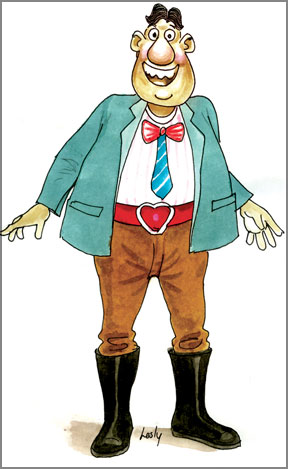Whose coat are you wearing, by the way?
 About a week ago I wrote about A E Goonesinha, the ‘Father of the
Labour Movement’ in our country to a weekly newspaper. The piece
prompted a lot of comment, including the following about his statue in
Goonesinhapura: ‘What a ghastly sanitization is the statue of the old
man breaking rocks, as punishment for refusing to pay the Road Tax, but
dressed to the Ts in full suit, minus only his fedora!’ About a week ago I wrote about A E Goonesinha, the ‘Father of the
Labour Movement’ in our country to a weekly newspaper. The piece
prompted a lot of comment, including the following about his statue in
Goonesinhapura: ‘What a ghastly sanitization is the statue of the old
man breaking rocks, as punishment for refusing to pay the Road Tax, but
dressed to the Ts in full suit, minus only his fedora!’
The issue of the suit hadn’t struck me until I received that email
from Tissa Devendra. It got me thinking about coats, though. The other
day I was passing the old Parliament building and saw D S Senanayake
being baked inside a full suit under the noontime sun. S W R D
Bandaranaike, green-tinged, seemed more breezy in contrast.
It’s not just statue ‘clothes’ of course. I remembered the title of a
Master’s thesis written by a colleague who is now a professor in a North
American university: ‘Time is a coat’. It was a study on labour
relations in the garment industry. The title referred probably to the
Marx’s theory of value generation and its relation to ‘labour time’. No
need to get into all that here of course.
I remembered also an anecdote related by cartoonist Vinnie Hettigoda.
This is a nutshell version.
A man borrows a friend’s coat. The two go on a journey, with the man
wearing his friend’s coat. Let’s call them ‘Lender’ and ‘Borrower’ for
narrative ease. They meet a mutual friend, and the Lender immediately
informs, ‘this coat...it belongs to me’. The Borrower is embarrassed and
requests that the Lender not make mention whose coat it is.
They meet another friend. Lender says, ‘This coat....it does not
belong to him’. Borrower is annoyed. He says ‘This coat, while we are on
this journey, does not belong to you, ok?’ Lender agrees. They meet
another man.
Lender: ‘This coat that my friend is wearing....it is not mine’. In
this way he communicates whose coat it is. Borrower says ‘can you stop
talking about the coat?’ Lender agrees. They meet a fourth person.
Lender: ‘This coat...well, let’s not talk about it!’

I can’t get down on print the facial expressions, the inflection and
emphasis, but it is not hard to imagine. Vinnies was talking about
censorship and how to get around it.
Clothes are political. They are political statements. They mark
status, class, religious faith, preferred identity and even political
affiliation. Coats are particular kinds of markers. They are class
identifiers. They give status. They help you believe that you’ve made it
across some kind of social barrier and are now a member of some elite
club. They are part of our culture now. Nothing wrong with wearing coat
and tie; it’s just another ‘garment’ after all. On the other hand, it is
good not to get carried away by dress, not what one wears and not what
one sees another wear.
I have found that dress covers a lot more than naked flesh. Clothes
are like words, I think. They are used to express something.
They are used to conceal, to disguise, to mislead, to impress, to be
seen, to be marked, to be accepted. They are used also to exclude; those
who dress differently, talk differently are basically given the message,
‘you don’t belong’ or ‘we are different’.
The words we use, the language(s) we speak, the accent that we grow
into and those that we acquire, constitute a wardrobe, it seems to me.
We pick and choose what we wear for which occasion and the company we
might find ourselves hanging out with. Like make-up, I suppose. Certain
perfumes for certain occasions, certain kinds of company. Different
coloured lipstick to go with different clothes.
Disguises, like words, can slip. There are ‘standards’ to follow.
Membership rules. If you get them wrong, you may lose membership. People
form clubs because they are comfortable with people who look like them,
think like them and act like them. They don’t like outsiders. This is
why there are rules. Similarly, if you want to be ‘one of them’ you have
to wear their clothes, do their thing, speak their speak etc. And you
have to keep it up. All the time.
I have no issue with people’s wardrobe preference. There is a popular
Hindi song which I believe addresses the issue of clothes and what they
mean, what they can mean, what you want them to mean and how important
they are to you. What matters in the end is not the cloth, the cut or
the appearance. It’s the definite article within. We hide even as we
reveal and we render ourselves naked even as we try to clothe ourselves.
This is not the first time I’ve thought of coats, clothes and
clothing (what they hide and reveal). I wondered, for instance, almost
four years ago: When we wear the clothes that are demanded of us, do we
stuff our unhappy skins in a trash can or turn them into drums beaten to
unfamiliar rhythms?
I think it is something to think about, these hot and humid days of
May. It won’t harm to ask ourselves whose coat(s) we are wearing or
desire to wear.
I think it is useful to ask ourselves what happened or happens to our
skin when we engage in ‘wardrobing’ and what kind of tunes we are able
to or allowed to dance to as a result.
[email protected] |



